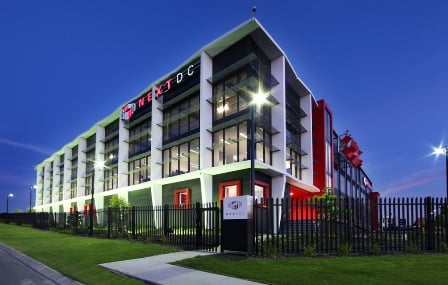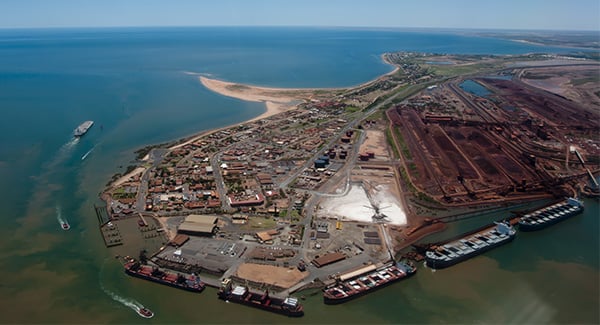Edge data centres
Getting closer to your target market has never been more important
Proximity matters, bring the edge to your business
In today's digital world, fast and reliable data transfer is crucial. NEXTDC's Edge Data centres specialise in providing low-latency, high-performance computing for latency-sensitive applications such as gaming, virtual reality, and IoT. Our facilities are strategically located, including at cable landing stations, to ensure optimal connectivity and lightning-fast data transfer speeds. With our carrier-neutral colocation facilities and expertise in data centre engineering and network infrastructure, trust NEXTDC to take your computing capabilities to the next level. Contact us today to experience unbeatable speeds.

How industry sectors are accelerating digital experiences with edge data centres
Edge data centres are revolutionizing the mining industry by enabling real-time monitoring and control of equipment. By deploying edge data centres closer to mines, companies can operate mining equipment remotely, reducing the need for on-site staff and improving safety. Edge data centres can also help with predictive maintenance by analyzing sensor data to identify potential issues before they cause downtime. Additionally, edge data centres can enable real-time processing of data from sensors, allowing for more accurate and efficient mineral extraction. With edge data centres, mining companies can optimize operations and improve their bottom line while enhancing safety and sustainability.
Gone are the days when IT departments were confined to managing workstations from a centralized location. With the advent of edge data centres, managing workstations remotely has become a game-changer. Edge data centres provide a perfect solution to companies looking to deploy remote distribution points for patching Windows machines in remote sites, reducing network bottlenecks and streamlining IT operations. Endpoint Manager technology from Microsoft is a prime example of how edge data centres can revolutionize IT operations and network management. Say goodbye to slow Windows updates and welcome a new era of seamless, efficient network management.
Manufacturing companies can benefit from edge data centres beyond just monitoring equipment in real-time with IoT sensors. Edge data centres can enable predictive maintenance by analyzing data from sensors and machine learning algorithms to identify potential issues before they cause downtime. Real-time quality control can also be achieved by analyzing data from sensors on the production line to identify defects and improve product quality. Additionally, edge data centres can optimize supply chain management by analyzing data from shipment sensors to optimize delivery routes and reduce costs. These are just a few ways that edge data centres can benefit the manufacturing industry beyond real-time monitoring.
Edge data centres offer low latency and proximity to connected devices, making them crucial for 5G network deployment. Telecommunications companies can also benefit from edge data centres in other ways:
- Smart city infrastructure - Telecommunication companies can work with local governments to deploy edge data centres to support smart city infrastructure, such as connected streetlights and traffic sensors. By processing data from these devices at the edge, telecommunication companies can provide real-time insights to city officials to optimize city services and improve public safety.
- Content delivery - Telecommunication companies can benefit from edge data centres for content delivery. By deploying edge data centres closer to the end user, telecommunication companies can reduce latency and improve the overall user experience for streaming media content.
These are just a few examples of how telecommunication companies can benefit from deploying edge data centres. With the growth of 5G networks and the increasing demand for low latency applications, edge data centres are becoming more and more critical for the telecommunications industry.
The financial services sector can greatly benefit from edge data centres, as they offer low-latency connectivity for mobile banking applications, improving customer experience and satisfaction. Here are a few examples how edge data centres can benefit the financial services sector:
- Fraud detection: Edge data centres can help financial institutions detect and prevent fraud in real-time by processing large amounts of transaction data from multiple sources at the edge. This enables banks to quickly identify and stop fraudulent activities before they cause financial losses.
- Trading: Edge data centres can provide low-latency connectivity for high-frequency trading firms, enabling them to execute trades faster and gain a competitive advantage in the market. This is especially important in today's fast-paced trading environment, where even a few milliseconds can make a difference.
- Customer experience: Edge data centres can improve the customer experience by enabling financial institutions to process transactions faster and more efficiently. This can help reduce wait times and improve overall customer satisfaction, leading to increased loyalty and retention.
- Compliance: Edge data centres can help financial institutions meet regulatory compliance requirements by storing and processing sensitive data closer to the source. This can help ensure that data is handled securely and in compliance with relevant regulations.
Overall, edge data centres provide financial institutions with the speed, security, and efficiency they need to stay competitive in today's fast-paced digital world.
Edge data centres are a game-changer for healthcare. They enable real-time data processing from IoT technology used in hospitals, including telemedicine, smart wearables, and robotic surgeries. This reduces the amount of time it takes to make critical decisions, leading to better patient outcomes. Additionally, edge data centres can provide secure and reliable connectivity for remote patient monitoring and telehealth services, allowing patients to receive care from the comfort of their own homes. With edge computing, healthcare providers can improve patient care and streamline operations, ultimately leading to better health outcomes and cost savings.
Edge data centres are revolutionizing the way media websites deliver content to users. Deploying content delivery networks hosted in remote edge data centres can serve media much faster, resulting in better user experience for their customers. Platforms like YouTube, Netflix, and Amazon are utilizing edge data centres to host their content closer to end-users, reducing latency and improving user experience. By leveraging content delivery networks (CDNs) hosted in remote edge data centres, these websites can ensure lightning-fast streaming and downloads, even during high traffic periods.
How industry sectors are accelerating digital experiences with edge data centres
Edge data centres are revolutionizing the mining industry by enabling real-time monitoring and control of equipment. By deploying edge data centres closer to mines, companies can operate mining equipment remotely, reducing the need for on-site staff and improving safety. Edge data centres can also help with predictive maintenance by analyzing sensor data to identify potential issues before they cause downtime. Additionally, edge data centres can enable real-time processing of data from sensors, allowing for more accurate and efficient mineral extraction. With edge data centres, mining companies can optimize operations and improve their bottom line while enhancing safety and sustainability.
Gone are the days when IT departments were confined to managing workstations from a centralized location. With the advent of edge data centres, managing workstations remotely has become a game-changer. Edge data centres provide a perfect solution to companies looking to deploy remote distribution points for patching Windows machines in remote sites, reducing network bottlenecks and streamlining IT operations. Endpoint Manager technology from Microsoft is a prime example of how edge data centres can revolutionize IT operations and network management. Say goodbye to slow Windows updates and welcome a new era of seamless, efficient network management.
Manufacturing companies can benefit from edge data centres beyond just monitoring equipment in real-time with IoT sensors. Edge data centres can enable predictive maintenance by analyzing data from sensors and machine learning algorithms to identify potential issues before they cause downtime. Real-time quality control can also be achieved by analyzing data from sensors on the production line to identify defects and improve product quality. Additionally, edge data centres can optimize supply chain management by analyzing data from shipment sensors to optimize delivery routes and reduce costs. These are just a few ways that edge data centres can benefit the manufacturing industry beyond real-time monitoring.
Edge data centres offer low latency and proximity to connected devices, making them crucial for 5G network deployment. Telecommunications companies can also benefit from edge data centres in other ways:
- Smart city infrastructure - Telecommunication companies can work with local governments to deploy edge data centres to support smart city infrastructure, such as connected streetlights and traffic sensors. By processing data from these devices at the edge, telecommunication companies can provide real-time insights to city officials to optimize city services and improve public safety.
- Content delivery - Telecommunication companies can benefit from edge data centres for content delivery. By deploying edge data centres closer to the end user, telecommunication companies can reduce latency and improve the overall user experience for streaming media content.
These are just a few examples of how telecommunication companies can benefit from deploying edge data centres. With the growth of 5G networks and the increasing demand for low latency applications, edge data centres are becoming more and more critical for the telecommunications industry.
The financial services sector can greatly benefit from edge data centres, as they offer low-latency connectivity for mobile banking applications, improving customer experience and satisfaction. Here are a few examples how edge data centres can benefit the financial services sector:
- Fraud detection: Edge data centres can help financial institutions detect and prevent fraud in real-time by processing large amounts of transaction data from multiple sources at the edge. This enables banks to quickly identify and stop fraudulent activities before they cause financial losses.
- Trading: Edge data centres can provide low-latency connectivity for high-frequency trading firms, enabling them to execute trades faster and gain a competitive advantage in the market. This is especially important in today's fast-paced trading environment, where even a few milliseconds can make a difference.
- Customer experience: Edge data centres can improve the customer experience by enabling financial institutions to process transactions faster and more efficiently. This can help reduce wait times and improve overall customer satisfaction, leading to increased loyalty and retention.
- Compliance: Edge data centres can help financial institutions meet regulatory compliance requirements by storing and processing sensitive data closer to the source. This can help ensure that data is handled securely and in compliance with relevant regulations.
Overall, edge data centres provide financial institutions with the speed, security, and efficiency they need to stay competitive in today's fast-paced digital world.
Edge data centres are a game-changer for healthcare. They enable real-time data processing from IoT technology used in hospitals, including telemedicine, smart wearables, and robotic surgeries. This reduces the amount of time it takes to make critical decisions, leading to better patient outcomes. Additionally, edge data centres can provide secure and reliable connectivity for remote patient monitoring and telehealth services, allowing patients to receive care from the comfort of their own homes. With edge computing, healthcare providers can improve patient care and streamline operations, ultimately leading to better health outcomes and cost savings.
Edge data centres are revolutionizing the way media websites deliver content to users. Deploying content delivery networks hosted in remote edge data centres can serve media much faster, resulting in better user experience for their customers. Platforms like YouTube, Netflix, and Amazon are utilizing edge data centres to host their content closer to end-users, reducing latency and improving user experience. By leveraging content delivery networks (CDNs) hosted in remote edge data centres, these websites can ensure lightning-fast streaming and downloads, even during high traffic periods.
Get the NEXTDC edge advantage
Edge colocation
100% Uptime
Interconnected
Fiber connected
Edge data centres frequently asked questions
What is an Edge Data centre, and how can it benefit my business?
An Edge Data centre is a decentralised facility located closer to end-users, enabling faster and more reliable access to data and applications. Benefits include faster application performance, reduced latency, improved user experience, enhanced security, and compliance with data privacy regulations.
How does an Edge Data centre differ from a traditional data centre, and why should I consider using one?
Edge Data centres are smaller, more agile, and designed to handle large volumes of data traffic with lower latency than traditional data centres. Organisations should consider using them to improve application performance, reduce network congestion, enhance security, and comply with data privacy regulations.
What kind of services does NEXTDC offer at its Edge Data centres?
NEXTDC offers a range of services at its Edge Data centres, including colocation, cloud computing, managed hosting, data storage, and network connectivity. Specialised services include IoT, content delivery, and real-time analytics.
How can NEXTDC's Edge Data centres help me to improve application performance and reduce latency for my end-users?
NEXTDC's Edge Data centres are strategically located closer to end-users, reducing latency and improving application performance. They are also designed with high-speed fiber links and redundant connectivity to ensure fast, reliable, and secure access to data and applications.
What factors should I consider when choosing an Edge Data centre provider, and why is NEXTDC the best choice?
Factors to consider when choosing an Edge Data centre provider include proximity to end-users, network connectivity, power and cooling infrastructure, security and compliance, and service level agreements (SLAs). NEXTDC is the best choice due to its expertise in network engineering, industry-leading SLAs, and commitment to delivering innovative, reliable, and secure data centre solutions and it come with a 100% uptime guarantee.















